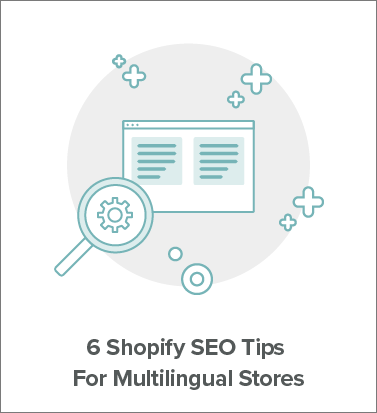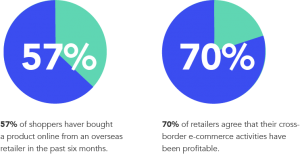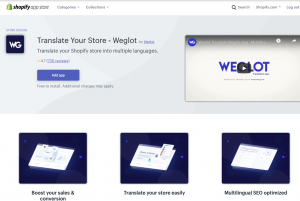6 Shopify Multi Language SEO Tips

With 12% of the market share, Shopify is the third most used CMS when it comes to selling online and is also one of the most recommended platforms when setting up your ecommerce presence.
However, as most ecommerce entrepreneurs know SEO is key when it comes to competing in an industry where consumers spent almost $3.46 trillion shopping online in 2019. It’s never been more important to increase your online visibility so you can sell more in such a competitive environment.
And, one of the key ways many ecommerce stores try to sell more is by making their store international. People are increasingly changing the way they shop online and in particular purchasing items outside of their home countries.

This is demonstrated in the size of the cross-border market, which is estimated to be worth €881 billion ($994 billion USD) in 2020.
So, with that in mind we’ll take you through some of the benefits of a multilingual store plus 6 fundamental Shopify SEO tips to increase your international store’s visibility.
Why make your Shopify store multilingual
When looking to sell more, one of the simplest ways is to diversify the markets you sell in. Not only are you no longer reliant on one market, but the pool of customers you can now sell to increases tenfold.
And, one of the simplest ways to enter a new market (although you’ll need to consider shipping and taxes) is to translate your website.
Language is often underestimated when it comes to selling internationally, however it’s one of the biggest deterrents when it comes to someone making a purchase on your Shopify store. If they can’t understand the language of your website, it’s highly unlikely they will convert.
In fact, 55% of online shoppers prefer to purchase in their own language and as many as 60% of people will hardly ever buy on a website if it’s not in their native language.
6 Shopify SEO tips for your multilingual store
1. Keyword research

Keyword research is also a big part of helping rank well for your translated Shopify store. Whilst you’ve probably spent a lengthy amount of time discovering keywords and what competition already exists, the same amount of work is recommended for your multilingual store.
Luckily for ecommerce entrepreneurs there isn’t as much in depth research needed when it comes to the keywords you’re looking to target as they are usually pretty predefined. For example you might be looking to target ‘white cotton t-shirt’ if that was an item you were looking to sell.
When it comes to your translated Shopify store you’ll need to identify new keywords within your new targeted languages. It’s not guaranteed that there will be a like-for-like translation – so bear in mind you might need to double check some keywords or ask a SEO expert fluent in the target language.
But, a tip for both the original and translated version of your Shopify store is to avoid keyword stuffing. Don’t overcrowd a page with a keyword just for the sake of it – Google and other search engines will pick up on this and penalise you for it. Instead, think where you can naturally place a keyword on your Shopify store.
A good place to identify and research keywords is Ahrefs and Ubersuggest.
2. Translation solution

Translating your Shopify store can from the outside seem like an impossible task. As an ecommerce store owner it’s likely you have thousands of product pages not to mention targeted popups, key information pages like delivery conditions and also your checkout.
It can be overwhelming to carry out such a translation task manually. Issues include looking for a translator (or multiple translators depending on how many languages you want to add) and then deciding how to display the translations of your store. Luckily for Shopify users, there are a number of Shopify translation apps that take the hassle out of translation.
But, when it comes to SEO you’ll need to consider how that translation solution displays the content of your ecommerce store. There are two ways translation apps can translate the content of your site.
The first way is “client-side” translation (JavaScript snippet). Your original content is sent to your site visitor, and it’s only there that the content is swapped with the translation. In certain situations this can be good, but it does make it hard for search engine bots, like Google bots, to index the translations because they can only technically “see” the original content of your Shopify store. This can then have a negative impact on your international SEO.
The second way is “server-side” translation. This is where the original content of your site is swapped with the translations before the page is sent to the visitor – the translations are in the source code of the page. This means search engine bots can detect it and index it.
Weglot, a popular Shopify translation app handles translations on the server-side so you can be sure your new multilingual Shopify store is also going to be visible on search engines.

3. Page titles and metadata

As with the original language of your site, page titles and your metadata are just as important for your multilingual store. This unique page metadata is what tells search engines what the page is all about and that will be displayed in search results.
SEO best practices state that the title should be 60 characters and 160 characters for the descriptions tag. It was probably a time consuming process to create these for the original language of your website but for those using Weglot as their Shopify translation solution, this step is automatically taken care of as any content from your Shopify store is automatically detected and translated.
We would recommend a quick review of the metadata translations to ensure you’ve used the right keywords (as mentioned above) and to trim down any of the descriptions if they translate to be more than the recommended character limit.
4. Unique URL for your translated Shopify store

When you translate your website one of the most important things to consider is how you’ll display those translations. Rather than creating duplicate pages or duplicate websites (which are not only time consuming to manage but costly too) using a Shopify translation solution such as Weglot means your store content will be both translated and displayed without duplicate sites.
The next important part of the puzzle is the URL structure. Weglot creates language subdirectories for each translated version of your pages which ranks favorably with search engines.
E.g. Italian version of a webpage

E.g. French version of the webpage

Note, these subdirectories are only visible to search engine bots, not you or your visitor. The most important part is that the bots recognize the content is under two different URLs which is ideal for the SEO of your multilingual Shopify store.
5. Hreflang tags

Hreflang tags are small elements in your page source code that tell Google about pages that are similar in content, but targeting different languages. They let search engines know about both the language of the page and what country it’s intended for.
This area can become a little more complicated if you’re not a developer as adding them to your Shopify store can be both complicated and time-consuming, particularly for beginners.
You can check out this useful guide from Google on how to implement hreflang tags.
Or, for those using Weglot as your Shopify translation solution, this step is already automatically taken care of for you – so you won’t need to worry about adding any additional code.
6. Image optimization

Optimizing the images on your Shopify store is necessary for improved SEO. Each image should include proper alt-tags with relevant keywords. Optimizing your images for search traffic is a key strategy for boosting the visitors to your online store.
A few key steps to consider when writing alt-tags:
Don’t keyword stuff – write a proper description
Use unique alt-tag per image
Short, concise descriptions
When selling in international markets, you need to make sure your alt-tags are also translated to gain the same benefits as your original language. This is again automatically taken care of when using Weglot as your Shopify multilingual store solution.
You can then go through and make any manual changes you think are needed based on keywords.
And, in terms of adding images to your website, best practice it to not add content inside the images as it’s harder to translate. However, with Weglot you can have specific images for each language, if you want.
Shopify Multi Language
We’ve gone through 6 key SEO tips that will help with the visibility of your Shopify store when you’re selling internationally. Let’s quickly recap them:
Keyword research – research translated keywords
Choose a translation solution that translates on the server-side
Translate your metadata & descriptions
Translated content under language specific subdirectories
Add hreflang tags
Optimize your image alt-tags
Ensuring that your Shopify multilingual store is SEO ready doesn’t need to be tricky if you choose a translation solution that takes care of all of the above.
